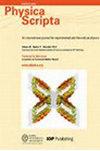使用 RSM 可取性方法优化低碳钢的线切割加工
IF 2.6
3区 物理与天体物理
Q2 PHYSICS, MULTIDISCIPLINARY
引用次数: 0
摘要
线切割加工(WEDM)是一种非传统的材料去除工艺,通常用于精密加工硬质材料,如超级合金、陶瓷、硬质合金和复合材料。工艺参数的优化对于提高加工效率和获得理想的表面质量至关重要。响应面方法(RSM)可系统地优化工艺参数,并研究其对加工性能的影响。在加工低碳钢的过程中,对脉冲开启时间 (TON) (50-60 μs)、脉冲关闭时间 (TOFF) (25-34 μs)、间隙电压 (VG) (25-250 V)、峰值电流 (IP) (1-6 A) 和介质流速 (Df) (1-3 LPM) 等线切割机床控制参数进行了优化,以降低表面粗糙度 (SR) 和锥角 (TA),同时提高材料去除率 (MRR)。最佳参数为 TON 为 53 μs,TOFF 为 28 μs,IP 为 2.65 A,VG 为 185 V,Df 为 1.5 LPM。实验结果证明了所提出的策略在优化线切割机床控制参数方面的实用性。在最佳条件下进行了验证测试,并报告了结果。制造业可以在制造领域使用 RSM 优化。本文章由计算机程序翻译,如有差异,请以英文原文为准。
Use of RSM desirability approach to optimize WEDM of mild steel
Wire Electrical Discharge Machining (WEDM) is a non-traditional material removal process commonly used for precision machining of hard materials such as super alloys, ceramics, carbide, and composite materials. Optimization of process parameters is critical for improving machining efficiency and achieving the desired surface quality. Response Surface Methodology (RSM) systematically optimizes process parameters and investigates their impact on machining performance. WEDM control parameters such as pulse ON Time (TON) (50–60 μs), pulse OFF Time (TOFF) (25–34 μs), gap voltage (VG) (25–250 V), peak current (IP) (1–6 A), and dielectric flow rate (Df) (1–3 LPM) are optimized to reduce surface roughness (SR) and taper angle (TA) while increasing material removal rate (MRR) during the machining of Mild Steel. The optimal parameters are TON as 53 μs, TOFF as 28 μs, IP as 2.65 A, VG as 185 V, and Df as 1.5 LPM. The experimental findings are presented to demonstrate the usefulness of the proposed strategy in optimizing WEDM control parameters. The validation test was conducted under optimal conditions and the results were reported. The manufacturing industries can use RSM optimization in the manufacturing domain.
求助全文
通过发布文献求助,成功后即可免费获取论文全文。
去求助
来源期刊

Physica Scripta
物理-物理:综合
CiteScore
3.70
自引率
3.40%
发文量
782
审稿时长
4.5 months
期刊介绍:
Physica Scripta is an international journal for original research in any branch of experimental and theoretical physics. Articles will be considered in any of the following topics, and interdisciplinary topics involving physics are also welcomed:
-Atomic, molecular and optical physics-
Plasma physics-
Condensed matter physics-
Mathematical physics-
Astrophysics-
High energy physics-
Nuclear physics-
Nonlinear physics.
The journal aims to increase the visibility and accessibility of research to the wider physical sciences community. Articles on topics of broad interest are encouraged and submissions in more specialist fields should endeavour to include reference to the wider context of their research in the introduction.
 求助内容:
求助内容: 应助结果提醒方式:
应助结果提醒方式:


